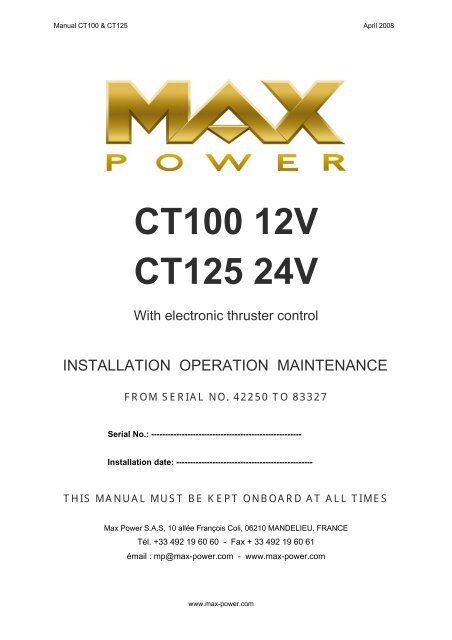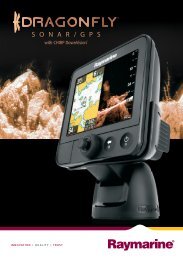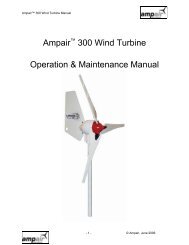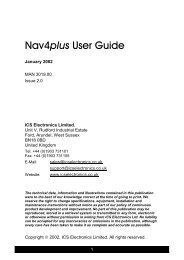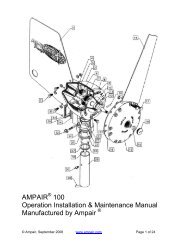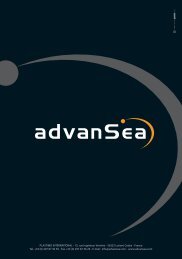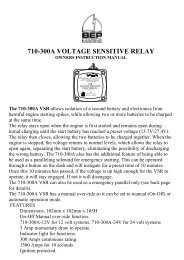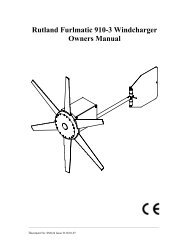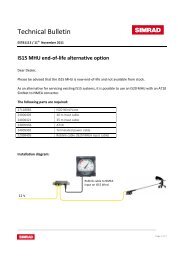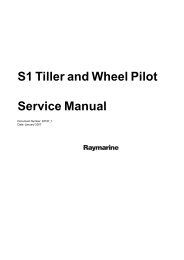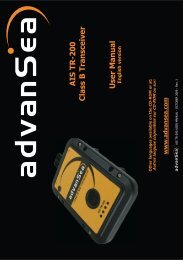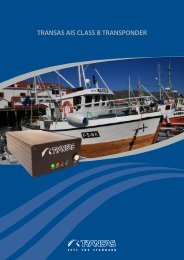CT100 12V CT125 24V - Max Power
CT100 12V CT125 24V - Max Power
CT100 12V CT125 24V - Max Power
You also want an ePaper? Increase the reach of your titles
YUMPU automatically turns print PDFs into web optimized ePapers that Google loves.
Manual <strong>CT100</strong> & <strong>CT125</strong> April 2008<br />
<strong>CT100</strong> <strong>12V</strong><br />
<strong>CT125</strong> <strong>24V</strong><br />
With electronic thruster control<br />
INSTALLATION OPERATION MAINTENANCE<br />
FROM SERIAL NO. 42250 TO 83327<br />
Serial No.: ------------------------------------------------------<br />
Installation date: -------------------------------------------------<br />
THIS MANUAL MUST BE KEPT ONBOARD AT ALL TIMES<br />
<strong>Max</strong> <strong>Power</strong> S.A.S, 10 allée François Coli, 06210 MANDELIEU, FRANCE<br />
Tél. +33 492 19 60 60 - Fax + 33 492 19 60 61<br />
émail : mp@max-power.com - www.max-power.com<br />
www.max-power.com
Manual <strong>CT100</strong> & <strong>CT125</strong> April 2008<br />
Contents<br />
Section Title Page<br />
1 General installation guidelines 2<br />
2 Tunnel 3<br />
3 Composite motor support and drive leg 4<br />
4 Electric Motor 5<br />
5 Propellers 5<br />
6 Protection grids 5<br />
7 Electrical installation 5<br />
8 Main power fuse 6<br />
9 Batteries 6<br />
10 Electronic control box 6<br />
11 Control panel and thruster control box functions 7<br />
12 Control panel installation 8<br />
13 Tests 9<br />
14 Electrical measurements 9<br />
15 Operation 9<br />
16 Alarms or thermal switch-off 10<br />
17 Safety 10<br />
18 Maintenance 10<br />
19 Electrical installation diagram 11<br />
20 Relay and control box connections diagram 12<br />
21 Spare parts diagram 13<br />
22 Spare parts list 14<br />
23 Troubleshooting guide 15<br />
24 Worldwide distribution network 15<br />
25 Warranty coverage 16<br />
26 Warranty form 18<br />
The use of qualified marine personnel, with experience in bow thruster installation, is<br />
strongly advised. Where possible, the boat manufacturer’s design departments, architects,<br />
and/or shipyards should be consulted, prior to installation taking place. For any boat requiring<br />
official classification, bodies of approval should also be consulted at the earliest opportunity.<br />
In any case, all other bodies, governmental or otherwise, should be contacted to ensure<br />
conformity with legal regulations relating to the boat in question.<br />
IT IS ESSENTIAL TO READ THE FOLLOWING MANUAL CAREFULLY<br />
BEFORE INSTALLING THE THRUSTER<br />
NB : The thruster is delivered without accessories (fuse, fuse holder, control panel).<br />
www.max-power.com 1
Manual <strong>CT100</strong> & <strong>CT125</strong> April 2008<br />
1. GENERAL INSTALLATION GUIDELINES<br />
In order to install the thruster in the most efficient position, follow the instructions below:<br />
• The minimum acceptable tunnel position is 139 mm below the waterline<br />
• The tunnel is ideally positioned when the distance between the waterline<br />
and the top of the installed tunnel is 185 mm<br />
• The tunnel must be installed as far forward as possible<br />
NB: A thruster turbine installed above its ideal position towards its minimum depth will<br />
lead to a progressive loss of performance.<br />
Whether vertical, inclined or horizontal, it is recommended to support the electric motor.<br />
The electric motor generates heat when in use. The zone in which the thruster is installed<br />
must therefore be dry and ventilated.<br />
The batteries used by the thruster must be charged by both the main engine's alternator<br />
and an appropriate battery charger.<br />
If the thruster is installed using a dedicated battery bank, this must be as close as<br />
possible to the thruster in order to reduce voltage loss in the electric cables.<br />
CAUTION: In no case should flammable products be stored near to the electric<br />
components of the motor.<br />
The drive leg must be centered in the tunnel and under no circumstances should the<br />
propellers of either models protrude out of the tunnel.<br />
www.max-power.com 2
Manual <strong>CT100</strong> & <strong>CT125</strong> April 2008<br />
2. TUNNEL<br />
Once the final tunnel position has been determined and all dimensions have been<br />
checked, mark the centre-point of the tunnel on both sides of the hull and drill holes of<br />
8 –10mm ∅ on either side.<br />
Using a metal rod, construct a compass with a 100mm radius. Insert through the holes<br />
and trace the ellipses, as shown below.<br />
After cutting the holes out following the elliptical guidelines, use an abrasive disc to<br />
prepare the inside and outside surfaces of the hull for laminating (approx. 10 to 15cm<br />
around the holes).<br />
Position the tunnel in the hull, mark the positions of the different components, as well as<br />
the areas that require laminating, then remove the tunnel. It is advisable to drill the tunnel<br />
before laminating it into position. See section 3 "Composite Motor Support and Drive leg"<br />
for more details.<br />
Replace the tunnel. To secure its position apply reinforced fibreglass filler to all areas,<br />
both inside and out, taking care to entirely fill the space between the hull and the tunnel.<br />
Laminate using a minimum of 8 layers of ISOPHTALIC RESIN alternated with mat and<br />
roving.<br />
In difficult to access areas (i.e. under the tunnel), it is possible to only apply reinforced<br />
filler.<br />
Once the filler has set on the outside, finish with a waterproof under coat, followed by<br />
sanding and application of a waterproof finish coat.<br />
In order to optimise the flow of water whilst sailing, and to avoid turbulence due to the<br />
tunnel, leave 1 to 4 cm of Finish these with several coats of reinforced filler in order to<br />
obtain the required hydrodynamic lines.<br />
Once all laminating work is complete, apply a watertight barrier.<br />
www.max-power.com 3
Manual <strong>CT100</strong> & <strong>CT125</strong> April 2008<br />
DO NOT LAMINATE THE AREA OF THE TUNNEL TO WHICH THE ELECTRICAL MOTOR<br />
SUPPORT WILL BE FIXED.<br />
3. COMPOSITE MOTOR SUPPORT AND DRIVE LEG<br />
The motor support and the drive leg must be centered in the tunnel.<br />
Locate and mark the intended position of the holes for the fixing screws and the leg hub.<br />
You can use the motor support and the leg’s gasket to mark these holes.<br />
In some cases it will be easier to mark and drill these holes BEFORE laminating the<br />
tunnel.<br />
After drilling, use the gasket to verify the holes’ axes and adjust them with a round file<br />
where necessary.<br />
These holes must be completely clean before inserting the screws.<br />
Position the leg, the gasket (between the leg and the tunnel) and the motor support,<br />
and then tighten the the two screws alternatively. Finally, mount the propeller(s) to control<br />
the general alignment.<br />
If the general set-up is correct, remove the propeller(s),the leg and the gasket.<br />
Apply a thin coating of silicon grease or sealing compound to both sides of the gasket<br />
(this must be resistant to hydrocarbons and water). Re-assemble all parts as before,<br />
positioning and then tightening the two 8mm ∅ screws alternatively using a 5.5mm Allen<br />
key (maximum torque: 25 Nm).<br />
Check that the propellers rotate freely, without resistance or friction.<br />
It is imperative that the holes and the screws remain free of sealing compound,<br />
otherwise there is a risk of an incorrect assembly of the parts.<br />
Caution: do not use graphite grease.<br />
NOTE:<br />
The composite drive leg:<br />
• is pre-filled with oil and sealed for life<br />
• does not require anodes<br />
• must not be disasembled, even partially (exclusion waranty)<br />
www.max-power.com 4
Manual <strong>CT100</strong> & <strong>CT125</strong> April 2008<br />
4. ELECTRIC MOTOR (12 / 24 volts)<br />
The upper coupling (motor side) is adjusted in the factory. Position the lower coupling on<br />
the drive leg shaft and push it down as far as it will go (lightly grease the shaft<br />
beforehand).<br />
Place the flexible red coupler on the drive leg side coupling, (part n° 8 on the <strong>CT100</strong><br />
<strong>CT125</strong> – Spare Parts diagram, page 13)<br />
Now fit the electric motor onto the motor support and tighten the four 10mm Ø motor<br />
support screws alternatively (maximum torque: 40Nm).<br />
Push the lower coupling up into place using a screwdriver et tighten the two 4 x 10mm<br />
Allen screws (maximum torque: 10Nm).<br />
The upper and lower couplings must be adjusted to leave 2mm of play (+/- 1mm)<br />
between both of them.<br />
Check that the propellers turn without resistance (a little resistance due to the motor is<br />
normal).<br />
Ensure that air can flow freely to allow the motor to cool whilst in operation.<br />
Please note that the motor side coupling is already in position and does not need<br />
adjusting.<br />
5. PROPELLERS<br />
Insert the drive pin and propellers.<br />
Check that the propellers turn without resistance (a little resistance due to the motor is<br />
normal).<br />
Tighten the fixing screw on the side of the propeller using a 3mm Allen key (maximum<br />
torque: 3 Nm).<br />
Protect your hands during this operation to avoid risks of injuries caused by the edges of<br />
the propeller blades.<br />
IMPORTANT: to prevent against calcium deposits that damage the seals, we<br />
recommend that you coat the shaft and stainless steel cover with silicon grease.<br />
6. PROTECTION GRIDS<br />
It is possible to install protection grids, however, their installation may affect thruster<br />
performance.<br />
7. ELECTRICAL INSTALLATION<br />
CAUTION: an incorrect electrical installation will cause rapid deterioration or even failure<br />
of the thruster. Excessive voltage drop will cause premature wearing of the relays and<br />
brushes. Special attention should be given to the quality, capacity and condition of your<br />
batteries, aswell as cable sections used.<br />
Ensure that all electrical connections are correctly tightened.<br />
Under no circumstances should any flammable products be stored next to the<br />
electrical components of the thruster.<br />
It is essential to install a manual battery isolator and if possible an electric<br />
battery isolator at the base of the thruster motor power line.<br />
www.max-power.com 5
Manual <strong>CT100</strong> & <strong>CT125</strong> April 2008<br />
When using a manual battery isolator it must be visible, clearly marked & easily<br />
accessible.<br />
Thruster motor power supply (12 V / 24 V):<br />
These values are given as an indication, assuming that the batteries are charged at<br />
100% and in charge, that is either 13.8V or 25.4V.<br />
The performance data of the is measured with an approx. consumption of 680A and 11V<br />
for the <strong>CT100</strong>, or 430A and 22V for the <strong>CT125</strong>, at the motor’s connections.<br />
Please refer to the characteristics given by the manufacturer of the batteries that will be<br />
used (see section 9 “Batteries”).<br />
<strong>Power</strong> wiring:<br />
Measure the shortest and most direct route possible between the battery(ies) and the<br />
electric motor; remembering to allow for both “positive and negative” cables.<br />
Recommended cable sections:<br />
Cable lengths <strong>CT100</strong> <strong>12V</strong> <strong>CT125</strong> 24 V<br />
L ≤ 5 m (2,5 x 2) 70mm² 50mm²<br />
5< L ≤ 10 m (5 x 2) 100mm² 70mm²<br />
10 < L ≤ 15 m (7,5 x 2) 150mm² 95mm²<br />
15< L ≤ 20 m (10 x 2) 200mm² 120mm²<br />
For all connections, use appropriate terminals for the cable sections chosen.<br />
It is possible to reduce the cable section to facilitate easy connection but only over a<br />
short distance. In this case, appropriated crimp fittings should be used at the<br />
connections.<br />
Please consult the "Electrical installation" diagram p. 11 for more information<br />
8. MAIN POWER FUSE<br />
Fuse sizes for overcurrent protection are to be determined on the basis of the cable<br />
sections in the circuit and NOT the amperage drawn by the appliance (thruster motor) in<br />
the circuit.<br />
Thruster <strong>Max</strong>imum Amperage <strong>Max</strong> <strong>Power</strong> Fuse size<br />
<strong>CT100</strong> / <strong>12V</strong> 550A 315<br />
<strong>CT125</strong> / <strong>24V</strong> 330A 200A<br />
9. BATTERIES<br />
Thrusters are high amperage consumers with instantaneous demands, thus, we<br />
recommend you use maintenance-free “starting” type batteries, with high CCA outputs.<br />
For example: Exide <strong>Max</strong>xima 900, <strong>12V</strong>, capacity 55Ah / starting current 800CCA.<br />
10. ELECTRONIC CONTROL BOX<br />
Install a fused circuit breaker / switch in the boat's main DC distribution panel marked<br />
BOW THRUSTER.<br />
This circuit breaker / switch should ideally be supplied from a different battery bank to the<br />
one used for powering the thruster.<br />
www.max-power.com 6
Manual <strong>CT100</strong> & <strong>CT125</strong> April 2008<br />
The installer must protect the positive supply cable of the thruster’s control box by means<br />
of a 8A fuse. The size of the power cables (red & black) depends on the length of the<br />
cable run, the voltage drop in these cables should not exceed 5% of the nominal battery<br />
voltage.<br />
For safety reasons, and in order to obtain all the functions provided by the thruster<br />
controller, an electric battery isolator needs to be installed in the thruster motor positive<br />
supply cable.<br />
<strong>Max</strong> <strong>Power</strong> advises the use of an electric battery isolator ref. OPTI3160/3 (<strong>12V</strong>)<br />
OPTI3170/3 (<strong>24V</strong>).<br />
If an electric battery isolator is not used then simply seal-off the two grey wires coming<br />
out of the control box. It is important to isolate the thruster motor power circuit by means<br />
of a manual battery isolator after having used the thruster.<br />
Please refer to the drawing “Relay and control box connections” p. 12 for more<br />
detail on the wiring of the control box to the thruster.<br />
11. CONTROL PANEL AND THRUSTER CONTROL BOX FUNCTIONS<br />
To switch the thruster ON or OFF follow the instructions given in the diagrams on the<br />
following page.<br />
When switched ON the control panel will beep once and the green LED in the red pushbutton<br />
will light up.<br />
When switched OFF the control panel will beep twice and the green LED in the red pushbutton<br />
will go out.<br />
The thruster controller provides a time delay between left and right thrust in order to avoid<br />
rapid direction changes. There is no delay when thrusting to same side.<br />
If the thruster motor overheats the control panel will start beeping and the green LED will<br />
flash until the thruster motor has cooled down.<br />
As soon as the overheating alarm sounds, there are 10 seconds of actual thruster use<br />
before the unit automatically shuts down. It will then not be possible to switch the thruster<br />
on until the motor has cooled down.<br />
If the thruster has not been used for a period of thirty minutes it will automatically<br />
switch itself off.<br />
Before switching off automatically the control panel will beep once followed by a second<br />
beep a few seconds later, after which the thruster switches itself off.<br />
In order to isolate the thruster motor power circuit, as described in the previous two<br />
paragraphs, it is necessary to install an electric battery isolator, as advised by <strong>Max</strong><br />
<strong>Power</strong>.<br />
Please consult the "Electrical installation" diagram p. 11 for more information<br />
www.max-power.com 7
Manual <strong>CT100</strong> & <strong>CT125</strong> April 2008<br />
12. CONTROL PANEL INSTALLATION<br />
Control panels should be protected from the natural elements while the thruster is not in<br />
use.<br />
Install the control panel(s) in easily accessible positions, without obstructing the main<br />
engine and/or steering controls.<br />
When fixing the panel with the stainless steel screws, make sure to install the pre-cut<br />
rubber seal, as supplied with the panel, ensuring that it is in the correct place.<br />
Only when totally finished and satisfied with the wiring and positioning of the unit,<br />
clip-on the face panel/cover.<br />
Please note that panels are only fully waterproof from the front, if installed correctly.<br />
However the area behind the dashboard should be kept dry to avoid the risk of<br />
oxidization of the cable connecter contacts.<br />
For full control panel installation instructions, please refer to the “Installation<br />
Guidelines" as supplied with each control panel.<br />
www.max-power.com 8
Manual <strong>CT100</strong> & <strong>CT125</strong> April 2008<br />
13. TESTS<br />
Activiating the thruster when the boat is out of the water, is not advised under<br />
any circumstances.<br />
Tests must be carried out with the boat in the water, the battery(ies) charged at<br />
100% and in charge, and the engines running.<br />
The maximum continuous operating runtime corresponds to S2-3mn norm.<br />
However, this can be affected by the ambient temperature.<br />
14. ELECTRICAL MEASUREMENTS<br />
In normal “usage” mode, i.e. thrusters running, boat in the water, with fully charged<br />
batteries under ongoing charge (alternator), electrical measurements should be made at<br />
the following points:<br />
At the batteries<br />
At the battery cut-off switch<br />
At the fuse<br />
At the electric motor’s connections<br />
At the power supply arriving at the thruster control box<br />
These measurements will enable you to detect voltage drop.<br />
NOTE: the voltage reading between the motor’s negative and positive connections<br />
should be approx. 10.5V for <strong>12V</strong> models or 22V for <strong>24V</strong> models during operation.<br />
The cumulative effect of voltage drops at these points can severely impair the<br />
thruster's performance.<br />
Should the voltage measured be too low, the following points need checking:<br />
Are the batteries of sufficient capacity ?<br />
Are the batteries good quality?<br />
Are the batteries sufficiently charged?<br />
Are appropriate cable sections being used?<br />
Are the connections sufficiently tightened?<br />
15. OPERATION<br />
With the control system circuit breaker/ switch and manual battery isolator switched on:<br />
Switch on the control panel, as previously described in the manual.<br />
Push the red button or incline the joystick to the left and the boat moves to the left.<br />
Push the green button or incline joystick to the right and the boat moves to the right.<br />
If, during tests the boat moves in the wrong direction, change around the blue and the<br />
brown wires on your power relay.<br />
When manoeuvring remember that the boat’s momentum continues after you release the<br />
joystick / button, therefore remember to release the control prior to reaching your desired<br />
position.<br />
Care must be taken not to use the thruster in areas where there may be people<br />
swimming or floating debris.<br />
<strong>Max</strong>imum running time: 2-3 min (depending on ambient temperature).<br />
www.max-power.com 9
Manual <strong>CT100</strong> & <strong>CT125</strong> April 2008<br />
16. ALARMS OR THERMAL SWITCH-OFF<br />
The thruster's electric motor is fitted with a thermal switch as standard. If the thruster<br />
motor overheats the buzzer in the control panel will start beeping and the green LED in<br />
the red-push button will flash until the thruster motor has cooled down again.<br />
As soon as the overheating alarm sounds, there are 10 seconds of actual thruster use<br />
before the unit automatically shuts down. The unit will then not be able to be switched on<br />
again until the motor has cooled down.<br />
17. SAFETY<br />
Switch off means to cut the power at both the DC equipment panel (control power supply)<br />
& the thruster battery isolator (thruster power supply) after having used the thruster.<br />
Under no circumstances should any flammable products be stored next to the electric<br />
components of the thruster. Care must be taken not to use the thruster in areas where<br />
there may be people swimming or in the water close to the thruster.<br />
CAUTION: Never tamper with the thruster / thruster turbine if not 100% sure that<br />
both the control and power circuits have been isolated, except if taking electrical<br />
measurements on the thruster motor or relay.<br />
18. MAINTENANCE<br />
Control panels should be protected from the natural elements while the thruster is not in<br />
use.<br />
The thruster requires a minimum of ongoing maintenance:<br />
Check the condition and charge of the batteries regularly, as voltage drop is the most<br />
frequent cause of rapid deterioration of the relay.<br />
Carry out a regular check of all electric components: batteries, connections, power<br />
cables.<br />
Remove the motor and clean out dust from the motor-brushes with compressed air.<br />
The electric motor must be kept dry and well-ventilated.<br />
NOTE: All maintenance should be carried out by qualified and authorised personnel.<br />
Composite drive leg and propellers:<br />
The composite drive leg is pre-filled with oil and sealed for life. It does not require the oil<br />
changing.<br />
The composite drive leg does not require an anode.<br />
The composite drive leg must not be disassembled, even partially (this would void the<br />
warranty)<br />
When the boat is out of the water, check that there are no fishing lines, plastic bags, etc.<br />
caught in the propellers.<br />
Paint the drive leg and propellers with antifouling (make sure that they were well<br />
prepared and primer has been used).<br />
Always keep the propellers and tunnel clean.<br />
To prevent the build up of calcium on the drive shafts, which would damage the oil seals,<br />
cover the drive shaft and the oil seals’ stainless steel covers with silicon grease before<br />
fitting the propeller(s). This should be done on an annual basis after the cleaning of the<br />
outside of the leg. Do not use aggressive solvents as they may damage drive leg seals.<br />
If drive leg oil seals are found to be worn, replace the drive leg with a standard exchange<br />
unit.<br />
THE MAX-POWER TEAM WISHES YOU SUCCESSFUL MANOEUVRING AND<br />
ENJOYABLE CRUISING<br />
www.max-power.com 10
Manual <strong>CT100</strong> & <strong>CT125</strong> April 2008<br />
19. ELECTRICAL INSTALLATION DIAGRAM<br />
www.max-power.com 11
Manual <strong>CT100</strong> & <strong>CT125</strong> April 2008<br />
20. RELAY AND CONTROL BOX CONNECTIONS<br />
www.max-power.com 12
Manual <strong>CT100</strong> & <strong>CT125</strong> April 2008<br />
21. SPARE PARTS DIAGRAM<br />
www.max-power.com 13
Manual <strong>CT100</strong> & <strong>CT125</strong> April 2008<br />
22. SPARE PARTS LIST<br />
N° Description Quantités Référence<br />
1 Electric motor <strong>CT100</strong> 12 V 1 MP083010<br />
1 Electric motor <strong>CT125</strong> 24 V 1 MP083011<br />
2 Motor fixing screws 4 MPOP4130<br />
3 Motor shaft drive key 1 MP115010<br />
4 Relay cover 1 MP082021<br />
5 Plastic screws for relay cover 2 MPOP4024<br />
6 Complete relay 12 V 1 MP083053<br />
6 Complete relay 24 V 1 MP083054<br />
7 Motor coupling 1 MP242220<br />
8 Red plastic coupling 1 MP24RED3<br />
9 Drive leg coupling 1 MP242216/2<br />
10 Motor support 1 MP058035<br />
11 Drive leg fixing screws 2 MPOP4130<br />
12 Drive leg / tunnel fibre seal 1 MPOP2060<br />
13 Drive leg key 1 MPOP5135<br />
14 Composite drive leg (includes n° 11, 12, 15) 1 MP088100<br />
15 Propeller drive pin 2 MPOP5221<br />
16 Propeller 2 MPOP8080<br />
17 Electronic control box 1 MPOP5701<br />
18 Fuse holder T2 for <strong>CT100</strong> 1 OPTI3091<br />
18 Fuse holder T1 for <strong>CT125</strong> 1 OPTI3119<br />
19 Fuse <strong>CT100</strong> 12 V 315 A 1 OPTI3121<br />
19 Fuse <strong>CT125</strong> 24 V 200 A 1 OPTI3112<br />
- Fuse extraction handle 1 OPTI3118<br />
www.max-power.com 14
Manual <strong>CT100</strong> & <strong>CT125</strong> April 2008<br />
23. TROUBLESHOOTING GUIDE<br />
Before contacting your nearest <strong>Max</strong> <strong>Power</strong> distributor, please check the below<br />
troubleshooting guide.<br />
Problem<br />
The control panel does not light<br />
up<br />
Check<br />
• Check the 6 wire connector behind the joystick<br />
• Check the thruster's electronic control box 6 wire<br />
connector<br />
• Check the circuit breaker / switch in the boat's<br />
main DC distribution panel<br />
• Check the control box's power fuse (8 A)<br />
The relays are clicking but the<br />
motor is not running<br />
• Check the motor's power fuse<br />
• Check the main battery isolator<br />
• Check the internal relay contacts<br />
• Check battery conditions and connections<br />
The motor is running but the<br />
thruster is not working<br />
• Check the propellers are fitted<br />
• Check the motor / drive leg assembly<br />
• Check that the tunnel is not obstructed or the<br />
propellers blocked<br />
The thruster lacks power • Check the propellers are fitted<br />
• Check the size of the batteries<br />
• Check the batteries are sufficiently charged<br />
• Check the connections are tightened correctly<br />
• Check the power cables sections<br />
(See p. 6 : Recommended cable sections)<br />
24. WORLDWIDE DISTRIBUTION NETWORK<br />
To locate the nearest <strong>Max</strong> <strong>Power</strong> distributor, please consult the section<br />
"Worldwide Distribution" on our website: www.max-power.com<br />
www.max-power.com 15
Manual <strong>CT100</strong> & <strong>CT125</strong> April 2008<br />
25. WARRANTY COVERAGE<br />
Introduction<br />
The purpose of this document is to set out the terms of warranty cover offered in relation to<br />
products purchased by the End User from <strong>Max</strong> <strong>Power</strong> or its approved network of resellers.<br />
This document will adhere to the following format:-<br />
Section 1<br />
Section 2<br />
Section 3<br />
Section 4<br />
Section 5<br />
Section 6<br />
Section 7<br />
Definitions<br />
Period of Coverage<br />
Warranty Registration<br />
Warranty Terms<br />
Warranty Exclusions<br />
Procedural Guidelines<br />
Service Centres<br />
1) Definitions<br />
Authorized Repair Number – The number given by <strong>Max</strong> <strong>Power</strong> on reporting a fault<br />
with your thruster<br />
Dealer – An authorized <strong>Max</strong> <strong>Power</strong> sales centre<br />
End User – The boat supplied with supplied equipment and the owner thereof<br />
Installer – The authorized centre responsible for the installation of your thruster<br />
Manufacturer – supplier of the equipment under warranty<br />
Pleasure Craft – Vessels used for owner’s personal use that have no commercial use<br />
(i.e Charter boats or work boats)<br />
Resellers – <strong>Max</strong> <strong>Power</strong> approved distributors and dealers<br />
Serial Number – Number in upper right hand corner of Warranty document<br />
Supplier – The manufacturer (<strong>Max</strong> <strong>Power</strong>)<br />
Warranty – The terms and conditions that are covered by the manufacturer<br />
2) Period of Coverage<br />
The equipment manufactured by the Supplier is guaranteed to be free from defective<br />
workmanship, components and materials under normal usage conditions for a period of two<br />
years from the date of purchase by the End User. This warranty is transferable to<br />
subsequent owners of this equipment during the period of coverage.<br />
3) Warranty Registration<br />
Register your purchase now to receive free extended warranty coverage. This can be done<br />
using one of the following methods (NB. proof of purchase must be included to establish that<br />
equipment is still under warranty):<br />
a) The quickest and easiest method to register your warranty is to fax the attached<br />
installation check list and warranty registration to the Manufacturer<br />
(Fax: +33 4 92 19 60 61)<br />
b) Mail in your warranty registration document, please ensure that you make a copy<br />
before sending it. (10 Allée F Coli, 06210 Cannes-Mandelieu, France)<br />
www.max-power.com 16
Manual <strong>CT100</strong> & <strong>CT125</strong> April 2008<br />
4) Warranty Terms<br />
If the material is used for anything other than for pleasure craft, the guarantee is limited to a<br />
six-month period.<br />
Year 1 - All factory testing, diagnosis, repairs and replacements are performed at no charge<br />
to the End User. All parts and up to two hours of labour are covered for repairs and<br />
replacements conducted in the field.<br />
Year 2 - All factory testing, diagnosis, repairs and replacements are performed at no charge<br />
to the End User. This excludes any damage or faults occurring from normal wear and<br />
tear on the following items: engine, oil seals, relay contacts(If warranty is registered<br />
within the 3 month period following installation)<br />
5) Warranty Exclusions<br />
Damage due to modifications or installation contrary to published specifications<br />
Cost of hauling the boat<br />
Damage due to repairs performed by an unauthorized service centre<br />
Damage due to lack of normal maintenance services<br />
Damage due to water<br />
Parts replaced due to normal wear and tear<br />
Repairs performed without knowledge of manufacturer (please contact dealer to receive<br />
Repair Authorization Number)<br />
Tampering of equipment by the End User<br />
Cost of travel to and from the job site<br />
Cost of economic loss, including injury to any person, damage to property, loss of income or<br />
profit, communication, lodging, inconvenience<br />
Consequential damage due to failure, including those arising from collision with other vessels<br />
or objects<br />
6) Procedural Guidelines<br />
PLEASE VIEW THE TROUBLE SHOOTING LIST TO ASCERTAIN OR SOLVE ORIGIN OF<br />
PROBLEM PRIOR TO CONTACTING THE DEALER/INSTALLER<br />
1) Contact your dealer/installer to report the problem.<br />
a. If you do not know who this is contact the nearest <strong>Max</strong> <strong>Power</strong> distributor<br />
b. If you are in foreign waters please contact the nearest <strong>Max</strong> <strong>Power</strong> distributor<br />
2) Ensure you have your serial number and model number to hand (top right hand<br />
corner of warranty)<br />
3) Dealer/Installer will come to site to decipher the cause of the fault<br />
4) If the cause of fault is due to a manufacturing problem the dealer will contact <strong>Max</strong><br />
<strong>Power</strong> to receive Repair Authorization Number.<br />
5) If the problem is due to an installation error please contact your installer.<br />
IF POSSIBLE: PLEASE TAKE PHOTOGRAPHS OF THE THRUSTER TO SHOW<br />
PROBLEM<br />
The warranty as outlined above is only applicable to <strong>Max</strong> <strong>Power</strong> manufactured<br />
thrusters and optional equipment as used in marine pleasure industry. The supplier<br />
holds the exclusive right to test the product and determine whether it is defective<br />
www.max-power.com 17
Manual <strong>CT100</strong> & <strong>CT125</strong> April 2008<br />
Serial No.:<br />
26. WARANTY FORM<br />
VERY IMPORTANT: Please complete this form and fax a COPY to <strong>Max</strong> <strong>Power</strong> with a<br />
copy of the installation invoice or the invoice of the yacht/boat in order for the<br />
warranty to come into effect.<br />
To be completed by the owner:<br />
Name of owner:<br />
Address:<br />
Postcode:<br />
Name of skipper:<br />
Owner's signature:<br />
Tel.:<br />
Email:<br />
Country:<br />
Tel:<br />
Date:<br />
To be completed by the installer:<br />
Installation details<br />
Thruster model:<br />
Installation date:<br />
Model and hull number of boat:<br />
Pleasure or commercial boat? :<br />
L.O.A:<br />
Waterline length:<br />
Tunnel Diameter, Thickness, Material & Length:<br />
Electric/Hydraulic:<br />
Date of launching boat:<br />
Builder:<br />
Build year:<br />
Hull construction material:<br />
Width:<br />
Poids total en charge:<br />
If Electric, Battery Type, Size & Number:<br />
Installation checklist:<br />
Electric : Before using thruster During use:<br />
Voltage at batteries<br />
Voltage at thruster motor<br />
Ampere in motor power circuit<br />
Mechanical:<br />
Check if the drive coupling between the motor and drive leg is correctly tightened:<br />
Check cable connections are sufficiently tightened:<br />
The thruster installation has been checked and the thruster functions correctly?<br />
YES / NO<br />
Important: Please consult this manual for more details<br />
Name of Installer: …………………………….<br />
Signature:.…………………………………..<br />
PLEASE RETURN BY FAX: + 33 4 92 19 60 61<br />
TO GAIN YOUR WARRANTY COVERAGE<br />
www.max-power.com 18


